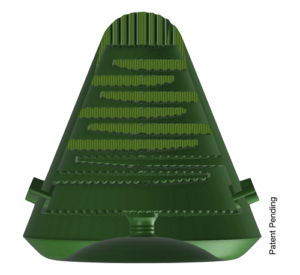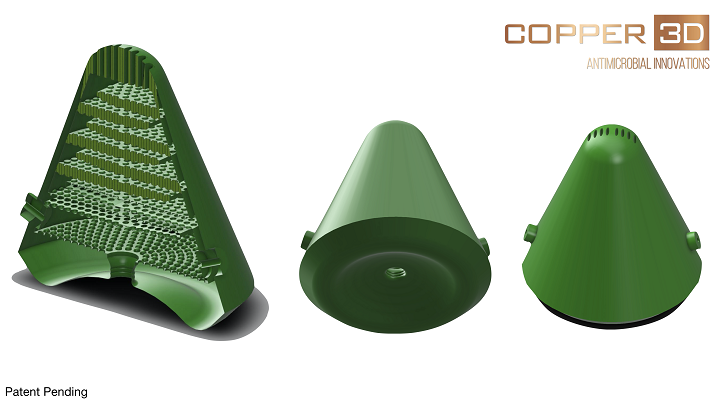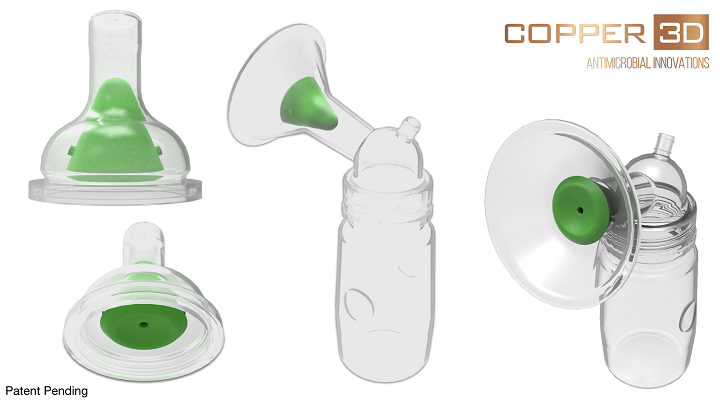 3D printing startup Copper3D, based in Chile and the US, uses nano-copper additives, and adds antimicrobial properties to polymers like PLA and TPU to create antibacterial 3D printed objects. Last year, Copper3D partnered with NASA to study microbial risks in outer space, but now the startup is working on an important project that’s a little closer to home.
3D printing startup Copper3D, based in Chile and the US, uses nano-copper additives, and adds antimicrobial properties to polymers like PLA and TPU to create antibacterial 3D printed objects. Last year, Copper3D partnered with NASA to study microbial risks in outer space, but now the startup is working on an important project that’s a little closer to home.
According to UNICEF, the number of children and adolescents living with HIV in 2017 reached 3 million, with 430,000 newly infected people and 130,000 deaths from AIDS-related causes. UNAIDS reports that in 2018, 26,000 new HIV infections among children up to the age of 14 resulted from withdrawal of treatment during pregnancy, and breastfeeding. But even with this knowledge, the World Health Organization reports that 37.9 million people around the world were living with HIV at the end of 2018, 8.1 million of which didn’t even know they had the disease to begin with.
Companies and scientists around the globe are working to use technology to help control dangerous bacteria and viruses with high replication rates, like HIV. Copper3D has created a 3D printed device, with its copper nanotechnology, that can effectively inactivate the HIV virus under the right conditions on certain objects- a project that the startup’s Director of Innovation Daniel Martínez tells us is “the result of more than one year of research in antimicrobial polymers and the role on inactivating high replication rate viruses like HIV.”
Dr. Claudia Soto, Copper3D’s Medical Director, said, “Understanding the global problem behind the HIV statistics and analyzing the role that our antimicrobial materials could have in containing the transmission of HIV virus led us think that we could develop some kind of device that acts like an interface between mother and child to prevent the spread of this virus through breastfeeding, which is one of the main routes of infection.
“The initial idea is based on some of the few available studies that establish that copper based additives and filters can inactivate HIV virus in a solution of breastmilk, acting specifically against the protease (essential for viral replication) where copper ions non-specifically degrade the virus phospholipidic plasmatic membrane and denaturalize its nucleic acids; nevertheless, several issues such as toxicity levels, milk nutritional degradation, time for virus inactivation, or the optimal size/form of these filters remain unsolved.”
Copper3D, led by co-founders Martínez, Dr. Soto, and CEO Andrés Acuña, began work on a project with, as the startup stated in a release sent to 3DPrint.com, “two lines of research.” Last year, they submitted a patent application for the project, called Viral Inactivation System for a Breastmilk Shield to Prevent Mother-to-Child Transmission of HIV. First, the viral inactivation effectiveness of its PLACTIVE material was tested with samples of HIV-infected breast milk, and then the team designed an object that optimizes the “viral inactivation of HIV” in the milk, acting as a mother-to-child interface during breastfeeding.
“Our purpose as a company has always been related to make a global impact through innovation in materials and nanotechnology. This line of research of active/antimicrobial medical devices and applications that opens with these studies, fills us with pride as a company. We believe that we are marking a before and after in the industry and we take this honor with a great sense of responsibility,” stated Acuña. “We will continue on the path of applied innovation, always thinking of playing an important role in the most urgent global healthcare challenges, where our antimicrobial materials, intelligent 3D designs, rigorous processes of technical validations and laboratory certifications, can generate a new category of antimicrobial/active devices that can avoid infections at a global scale and save millions of lives.”
The startup commissioned a proof-of-concept laboratory study at the Hospital Clínico Universidad de Chile’s Virology Laboratory to validate PLACTIVE’s potential HIV viral inactivation capacity. The study used a split-sample protocol to test and treat 20 sub-samples of HIV-1 (subtype B, cultivated from infectious clone NL4-3, with CXCR4 co- receptor).
The sub-samples were randomized into different groups: A, B, and Control. Samples for A and B were placed in either a green or blue 3D printed box, with and without the nano-copper additive; for a proper blind study, the researchers did not know which was which. The samples were exposed to the medical device for 15, 60, 120, and 900 seconds, and then cultured with HIV-1 Jukat reporter cells LTR-luciferase Cells (1G5); Copper3D performed culture measures on the samples 24, 48, 72, and 96 hours post-treatment.
“The preliminary results showed a reduction of viral replication up to of 58.6% by simply exposition of the samples to the 3D printed boxes containing copper nanoparticles. Fifteen (15) seconds of exposition were enough to achieve such a reduction. These data allow us to infer that by increasing the contact surface by a factor of 10X, we could obtain much higher inactivation rates, very close to 100% (log3) and according to our calculations, most probably in less than 5 seconds,” explained Martínez. “These results are coherent with the hypothesized reduction times proposed by Borkow, et. al. To the best of our knowledge, this is the first essay aiming to study the inactivation of HIV virus by using this new kind of polymers with antimicrobial copper nanotechnology in 3D printed objects.”
These results are pretty promising, which bolstered the team as they moved on to the second part of the study – designing a device, with a surface of contact expanded 10X, for HIV-contaminated milk, that’s embedded in nano-copper for use during breastfeeding.
“Like any innovation project, this is a constantly evolving process. We have learned a lot along the way, and we will continue designing, iterating, testing, validating and learning about antimicrobial materials and devices in the future. The preliminary results obtained in the first phase of our investigation with viral inactivation on active/antimicrobial nanocomposites materials gives us a great drive to continue in that line of research,” said Martínez. “We hope in the coming months to conclude the second phase of this study. For these purposes we develop a new antimicrobial flexible TPU based material (MDflex), with the same nanocopper additive as PLACTIVE, to test with new iterations of the design of this viral inactivation device with expanded surfaces of contact that we believe will be much more effective. These new insights will allow the development of a whole new range of active medical devices and applications, with incredible capabilities to interact with the environment, eliminating dangerous bacteria and viruses and protecting patients and users around the globe. This second and final phase of the study will be concluded in Q2 of 2020.”
Copper3D’s concept for its Viral Inactivator is to study how the antimicrobial capacity of its nano-copper materials impacts HIV inactivation, and how different shapes and designs for the 3D printed device can increase the surface of contact with breast milk, while using the nano-copper to enhance effectiveness. The device was made with various layers and “rugosities” in order to imitate what has been observed in the human gastrointestinal tract.
Collaborators at the University of Nebraska at Omaha’s Department of Biomechanics will perform mechanical characterization testing of Copper3D’s prototype.
“Copper3D has once again disrupted the field of medical devices by creating this revolutionary device that can have a tremendous impact in reducing mother-to-child transmission of HIV,” said Jorge Zuniga PhD, Associate Professor of Biomechanics with the university. “Our laboratory is fortuned to partner with Copper3D, in such an impactful project.”
Discuss this and other 3D printing topics at 3DPrintBoard.com or share your thoughts below.
The post Copper3D Antimicrobial Filament Device Attempts To Reduce HIV Transmission From Breastfeeding appeared first on 3DPrint.com | The Voice of 3D Printing / Additive Manufacturing.






225 Replies to “Copper3D Antimicrobial Filament Device Attempts To Reduce HIV Transmission From Breastfeeding”
Comments are closed.